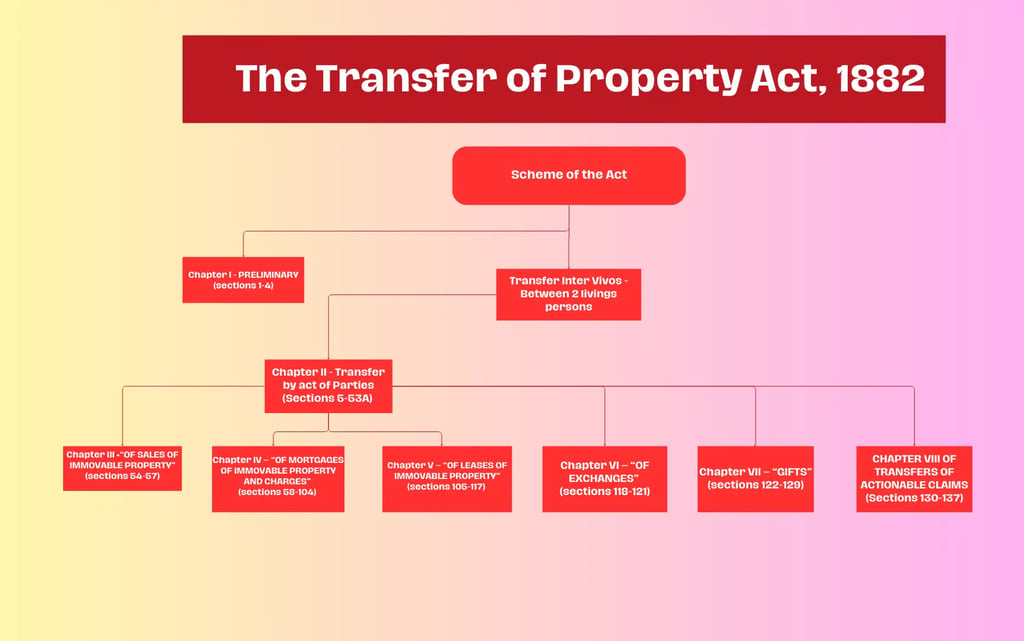Transfer of Properties in India; Law, Practice and Procedures
To provide you with complex legal material regarding the Law governing Transfer of properties in India, with more reliance on the Transfer of Property Act, 1882.
Author, THelawcritiQue
5/3/20255 min read


Introduction to Transfer of Property Act In India
What you will learn in this article:
Introduction
Background of the Act
Scheme of the Act
Comparison between Transfer of Property and Will
Conclusion
In a civilian economical and financial transactions, transfer of property play a major important role as it forms basis of all kinds of transfers. Thus knowing about the laws and legal decisions regarding the Transfer of Property is paramount for any citizen not just legal fraternity but also the litigant public. Hence it is very important to know about the law relating to Transfer of Property in India.
Introduction to Transfer of Property Act, 1882
The transfer of property act governs the law, legal principles, essential prerequisites, limits and liabilities, rights and duties regarding the parties to a valid transfer enunciated under the act. The preamble of the act reads as follows, – “WHEREAS it is expedient to define and amend certain parts of the law relating to the transfer of property by act of parties; …” which actually means that the Transfer of Property governs only transfers or alienations which were affected by an act by two living persons also known as transfer inter-vivos.
Background of the act
Earlier the personal law principles of Hindus and Muslims were in force regarding their respective fields of transfer of property. When the British rule was implicated in India, the British government though delegated the duty of administration of justice to courts; there is no formal and consolidated law to govern transfer of property in India. Judges used to rely on the principles of justice, equity and good conscience in order to decide cases before them which led to a sound state of inconsistency and uncertainty in the process of administration of justice regarding the transfer of property. This mandated the establishment of a definitive and formal law to govern the transactions relating to transfer of property in India. The privy council also advised the parliamentary authorities to act on this and thus a law commission was established to prepare a draft removing the uncertainties and inconsistencies regarding the law of transfer of property. A draft was prepared and after various discussions, amendments and expansion of provisions and shaping the law to suit the Indian people The Transfer of Property Act, 1882 was finally enacted on 17th February, 1882, coming into force on 1st July, 1882.
The act consists of 137 sections divided into 8 chapters each dealing with a particular kind of transfer. The act also has one schedule. The act introduces various principles regarding transfer between two parties.


Chapter I – of the act containing of sections 1-4 deals with preliminary aspects regarding the act, short title and commencement; interpretation clause; repeals etc.
Chapter II – of the act deals about “OF TRANSFERS OF PROPERTY BY ACT OF PARTIES” gives us basic principles of transfer of property applicable for all the kinds of transfer of property contained in sections 5 to 53A. The chapter contains most important and established legal principles relating to transfer of property which might be applicable to any transfer. In Om Prakash Gupta’s case, – the Supreme court held “even if provisions of Transport Property Act, 1882 or not applicable the principles flowing from the provisions of the act can be applied.”
Chapter III – containing sections 54-57 deal about “OF SALES OF IMMOVABLE PROPERTY” lay out provisions establishing the principles regarding sale of immovable properties which is a complete transfer of immovable property from one person to another in return for a price paid or promised, conditional or final.
Chapter IV – containing sections 58-104 deal about the provisions relating to “OF MORTGAGES OF IMMOVABLE PROPERTY AND CHARGES” establishing all the essential rules and regulations relating to mortgage of immovable property including various kinds of mortgage, charge, rights and duties of parties to a mortgage, redemption of mortgage etc.,
Chapter V – “OF LEASES OF IMMOVABLE PROPERTY” dealt in sections 105-117 give us the provisions relating to the lease of immovable property, rights and duties of lessor and lessee, meaning and definition of lease. Lease is a transfer where the transferor gets into the possession of the immovable property for a definitive period of time upon paying agreed consideration to the transferee which is called as rent.
Chapter VI – of the act deals about “OF EXCHANGES” in sections 118-121 which defines what is exchange of immovable property, rights and duties of parties in an exchange, exchange of money. The exchange is a kind of transfer where one property is transferred by receiving another property from another person.
Chapter VII – dealing with GIFTs of immovable property in sections 122-129 which is the only kind of transfer provided under the act which does not mandate consideration in return in the form of money or any other kind of value. A gift is made out of love and affection on the other party which itself is a consideration and shall be binding against the person who made it.
Check out : When does a gift deed become Valid? for more clarification on Gifts.
Chapter VIII – deals about TRANSFER OF ACTIONABLE CLAIMS dealt in sections 130-137. An actionable claim refers to a claim against a person which is enforceable through a court of law viz., a debt. The act also specifies for transfer of property not only movable and immovable but also of an actionable claim.
Transfer of property and Will. –
Though both the transfer of property and Will deals with conveyance of ownership in property from one person to another person, both the transfer of property and Will are completely different kinds of transactions and governed by different legal principles. The Transfer of Property Act itself clarified that it deals with transfers by act of two living persons. That means any transaction between a person who is already dead does not come under the purview of the Transfer of Property Act, 1882. Such kinds of transfer are dealt under the law of testamentary succession and the document written by the person is called as Will.
The difference between the Transfer of Property and Will was clearly distinguished by the Karnataka High Court while disposing N. Ramaiah v. Nagaraj S ., AIR 2001 Kant 39 (DB) as “The differences between a transfer and a Will are well recognized. A transfer is a conveyance of an existing property by one living person to another (that is transfer inter- vivos), On the other hand, a will does not involve any transfer, nor effect any transfer inter-vivos, but is a legal expression of the wishes and intention of a person in regard to his properties which he desires to be carried into effect his death. In other words a Will regulates succession and provides for succession as declared by it (testamentary succession) instead of succession as per personal law (non-testamentary Succession) concept of transfer by a living person is wholly alien to a Will.”
Conclusion. – thus the transfer of property act formally introduced various provisions and principles that are mandatory to effectuate a valid transfer between two living persons but does not include transfer between dead persons. The transfer may also be between two juristic persons such as a company, firm, association or a society. Going further into the blog we discuss about the most important topics of the Transfer of Property Act in detail in the following articles that are going to be published on our website. Next up we will discuss about “What is Transfer of Property, as defined under Section 5 of the Transfer of Property Act, 1882.”
For further clarification on Transfer of Property read : What is Transfer of Property
Connect With Us Through
Connect with us
© 2025. All rights reserved.
